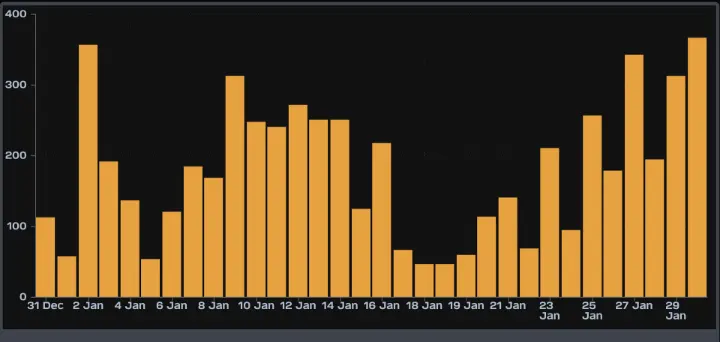A Wet and Cold Start to the Year
Welcome to the January monthly overview for MeteoTielt - Weather Station Tielt.
The first month of 2025 was marked by changeable and cold weather. With an average temperature of 3.6°C and frequent precipitation, it was a typical winter month. The sun rarely appeared, and the wind occasionally brought harsh conditions. Here is an overview of the weather in January 2025.
Temperature Trends
The month started with relatively mild temperatures, with maximums around 10°C on January 1st and 2nd. A slight cooling followed, with some nights hovering around or just below freezing.
By mid-January, a clear drop in temperatures was observed, with several days where minimums fell below freezing and maximums remained just a few degrees above zero. This was followed by a milder period, with temperatures rising back to 8-10°C.
Towards the end of the month, temperatures increased again, peaking above 10°C, resulting in a relatively mild end to the month. The fluctuations between day and night temperatures were significant, which is typical for a changeable winter month.
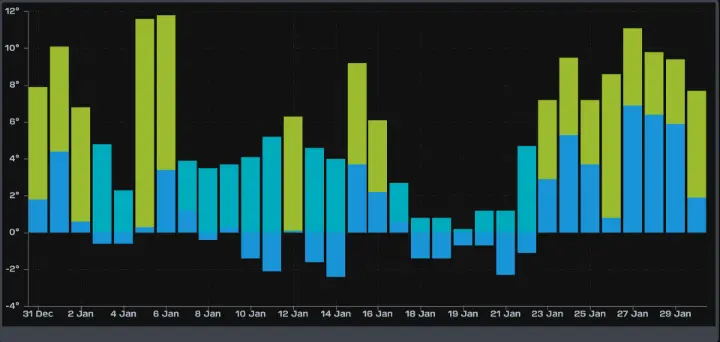
Precipitation:
The first month of the year brought a varying precipitation pattern in Tielt, with some days standing out due to significant rainfall. Here is an overview of the main trends and notable days.
General Weather Pattern
January 2025 saw several wet periods, interspersed with drier intervals. The rainfall was not evenly distributed; instead, some days recorded exceptionally high amounts, while others remained almost dry.
Precipitation Highlights
- December 31 & January 1: The transition to the new year brought a significant amount of rainfall, peaking around 20 mm on New Year’s Eve.
- January 8 to 10: A rainy spell, with January 10 recording the highest rainfall at approximately 15 mm.
- anuary 23 & 25: Another wet phase, with both days seeing notable peaks of 15 to 18 mm.
- End of January: The month concluded with more evenly distributed rainfall, with no extreme peaks but several days of moderate rain.
Dry Periods
Despite the heavy showers, there were also extended dry periods. Notably, the period between January 12 and 19 was strikingly dry, with minimal precipitation.

Wind:
January in Tielt was notably windy, with interesting trends in both wind speed and direction.
Wind Speed
The wind speed data showed significant variations throughout the month. Peak wind events occurred on January 6, 23, and 27, with the highest speeds reaching up to 70 km/h due to strong westerly currents. Outside these peaks, wind speeds were generally stable and moderate, averaging between 20 and 30 km/h.
Periods of intense wind activity were often followed by calmer days, indicating a typical alternation between stormy and high-pressure influences in January.
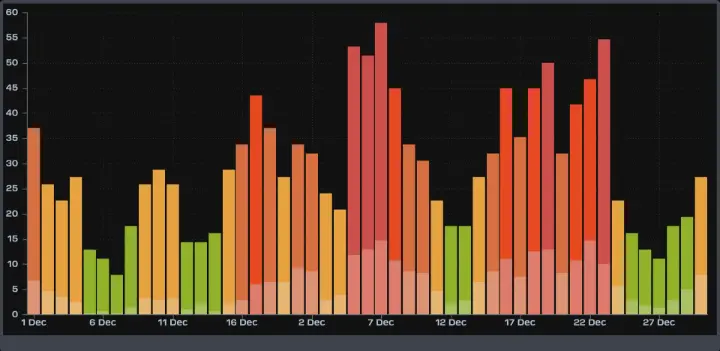
Wind Directions
The prevailing winds in January were predominantly from the southwest, as shown in the second chart. Southwest and westerly winds dominated, which is typical for this time of year in Belgium. Occasionally, easterly and even northeasterly winds were observed, indicating brief periods of continental airflows.
These wind directions were influenced by dominant weather systems, with low-pressure areas from the Atlantic Ocean driving air currents westward and southwestward.
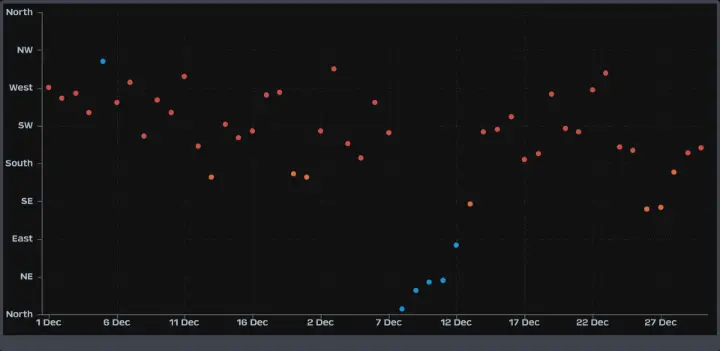
Sunshine and UV Index:
A Variable Sun Pattern
The data shows a few distinct sunny days, mainly around mid-January and towards the end of the month. This coincides with peaks in solar energy production and UV index levels.
The first week of January had some clear moments, particularly on January 2, which was noticeably sunny. A more changeable phase followed, with only occasional sunshine. Between January 10 and 16, several days had prolonged sunshine, which is reflected in the increased UV values.
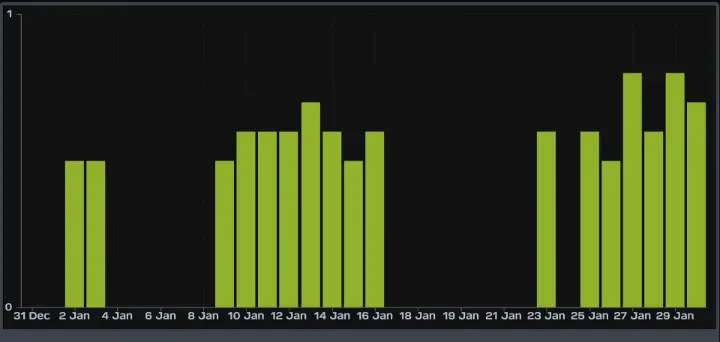
Second Half of January
After a gloomy spell around January 18, the sun returned from January 23 onwards. The last week of the month recorded the most sunshine hours, with peaks on January 27 and 29. This resulted in a relatively sunny end to the month, despite the shorter days.
Air Quality:
Air quality in Tielt fluctuated significantly in January, with periods of relatively clean air alternating with phases of increased pollution. This overview provides a detailed analysis of the air quality index (AQI) and associated health risks.
A Variable Start
The month started with mixed air quality. On January 1, the AQI was moderate, just below 100, but the following days saw an improvement, with values falling into the green zone, indicating good air quality.
However, by January 5, the AQI spiked above 100, signaling a decline in air quality to a level where sensitive groups might experience discomfort. This peak was followed by fluctuating air quality, with AQI values oscillating between moderate and healthy levels.
Mid-January: Peak Pollution
The highest pollution levels were recorded between January 14 and 17, with the highest AQI of 130.3 on January 17. This falls within the ‘moderate to high risk’ category, meaning individuals with respiratory conditions needed to be extra cautious. Possible causes include unfavorable weather conditions, increased emissions from heating, and limited air circulation..
Improvement Towards the End of the Month
After the mid-month peak, air quality gradually improved. By January 24, the AQI returned to moderate levels, and by the last few days of the month, values were consistently in the green zone, indicating clean air.
Conclusion:
January was a month of contrasts in terms of air quality in Tielt. While the first and last days were relatively clean, the middle of the month saw significant pollution. This underlines the importance of regular monitoring and preventive measures, such as avoiding strenuous outdoor exercise on high pollution days.
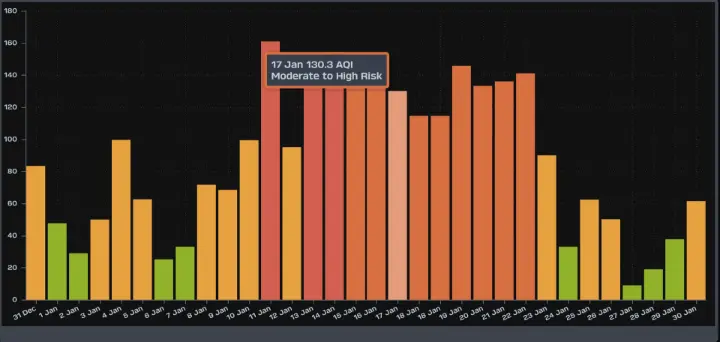
Conclusion
January 2025 was a typical winter month in Tielt, characterized by changeable and cold weather. Temperatures fluctuated significantly, with periods of frost interspersed with milder days.
Precipitation was irregular, with some wet phases and dry intervals. The wind played a prominent role, with a few stormy days and predominantly southwesterly winds.
Sunshine was scarce, though a few bright days provided relief from the gloomy winter skies.
Air quality showed some pollution spikes, particularly mid-month, but improved towards the end.
Overall, January offered dynamic and typically Belgian winter weather.
Stay updated with the latest weather developments with MeteoTielt - WeerstationTielt!
